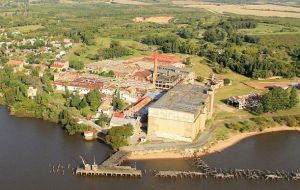MercoPress. South Atlantic News Agency
Ex-Anglo abattoir complex in Fray Bentos joins Unesco's World Heritage List
 Liebig Extract of Meat Co. exported meat extract and corned-beef to Europe from 1865 and the Anglo Meat Packing Plant frozen meat from 1924.
Liebig Extract of Meat Co. exported meat extract and corned-beef to Europe from 1865 and the Anglo Meat Packing Plant frozen meat from 1924.  The industrial complex was built following the development of a factory founded in 1859 to process meat produced on the vast prairies nearby.
The industrial complex was built following the development of a factory founded in 1859 to process meat produced on the vast prairies nearby. UNESCO's World Heritage Committee approved the inscription of four cultural sites on the World Heritage List: Fray Bentos Cultural-Industrial Landscape in Uruguay; Japan’s Meiji Industrial Revolution: Iron and Steel, Shipbuilding and Coal Mining in Japan, Ephesus in Turkey and Aqueduct of Padre Tembleque Hydraulic System in Mexico. The Committee also approved the extension of Spain’s Routes of Santiago de Compostela with the addition of the “Camino Francés and Routes of Northern Spain”.
The Fray Bentos Cultural-Industrial Landscape is located on land projecting into the Uruguay River west of the town of Fray Bentos, the industrial complex was built following the development of a factory founded in 1859 to process meat produced on the vast prairies nearby.
The site illustrates the whole process of meat sourcing, processing, packing and dispatching. It includes buildings and equipment of the Liebig Extract of Meat Company, which exported meat extract and corned-beef to the European market from 1865 and the Anglo Meat Packing Plant, which exported frozen meat from 1924. Through its physical location, industrial and residential buildings as well as social institutions, the site presents an illustration of the entire process of meat production on a global scale.
The other sites are: Japan's Meiji Industrial Revolution which encompasses a series of eleven properties, mainly located in the southwest of Japan. It bears testimony to the rapid industrialization of the country from the middle of the 19th century to the early 20th century, through the development of the steel industry, shipbuilding and coal mining. The site illustrates the process by which feudal Japan sought technology transfer from Europe and America from the middle of the 19th century and how this technology was adapted to the country’s needs and social traditions. The site testifies to what is considered to be the first successful transfer of Western industrialization to a non-Western nation.
Epheus in Turkey is located within what was once the estuary of the River Kaystros, Ephesus comprises successive Hellenistic and Roman settlements founded on new locations, which followed the coastline as it retreated westward. Excavations have revealed grand monuments of the Roman Imperial period including the Library of Celsus and the Great Theatre. Little remains of the famous Temple of Artemis, one of the “Seven Wonders of the World,” which drew pilgrims from all around the Mediterranean. Since the 5th century, the House of the Virgin Mary, a domed cruciform chapel seven kilometers from Ephesus, became a major place of Christian pilgrimage. The Ancient City of Ephesus is an outstanding example of a Roman port city, with sea channel and harbor basin.
The 16th century aqueduct of Padre Tembleque Hydralic System in aqueduct is located between the states of Mexico and Hidalgo, on the Central Mexican Plateau. This heritage canal system encompasses a water catchment area, springs, canals, distribution tanks and arcaded aqueduct bridges. The site incorporates the highest single-level arcade ever built in an aqueduct. Initiated by the Franciscan friar, Padre Tembleque, and built with support from the local indigenous communities, this hydraulic system is an example of the exchange of influences between the European tradition of Roman hydraulics and traditional Mesoamerican construction techniques, including the use of adobe.




Top Comments
Disclaimer & comment rules-

-

Read all commentsClearly a great start for Uruguay by the British investors and the plants' management.
Jul 06th, 2015 - 11:59 am 0What a pity that the political children of the Broad Fraud are unable to match it.
“No Money Pepe” was U$D 1,900 Million in the red at the latest accounting by the new administration. That's U$D 575 for every man woman and child in the country. In reality probably U$D 1,000 for each taxpayer.
Many of the previous lot are still in positions of power including Astori the Finance Minister. Why didn't he do something about it when Pepe was pissing our taxes away on the stinking poor.
Stinking poor is not untrue, you only have to stand behind these morons at the checkout to realise that.
There is no excuse for not looking after yourself and your children.
Fray Bentos - South Americas only contribution to the world. And, of course originally stewarded by the British.
Jul 06th, 2015 - 02:17 pm 0Commenting for this story is now closed.
If you have a Facebook account, become a fan and comment on our Facebook Page!